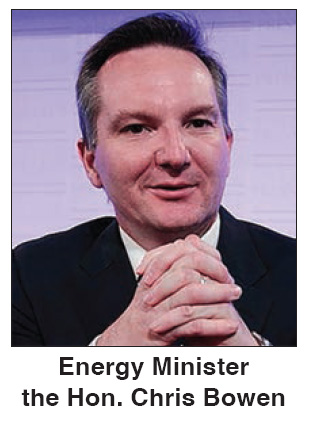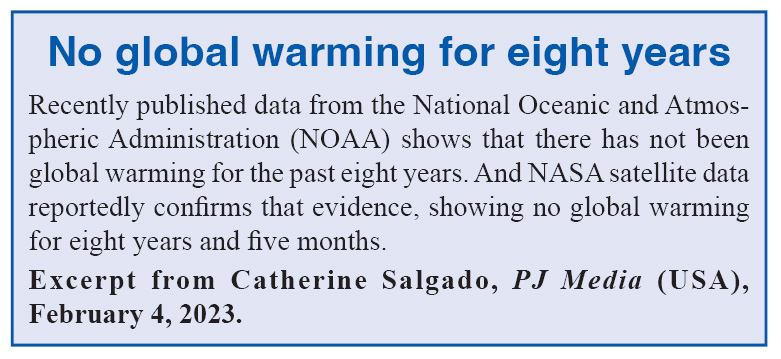Unaffordable make-believe of a renewables future by John Morrissey
 Why must Australian households and industries struggle to
survive under some of the highest energy prices in the world,
when our continent is endowed with an abundance of energy
resources that are the envy of the world?
Why must Australian households and industries struggle to
survive under some of the highest energy prices in the world,
when our continent is endowed with an abundance of energy
resources that are the envy of the world?
This can be explained by the election of a federal Labor government with a stated ambition of achieving net zero carbon dioxide emissions by 2050. This has resulted in massive contradictions in policy implementation which would be amusing were the outcomes not so dire.
Journalist Chris Kenny has summed up the situation brilliantly. He writes: "Enforceable renewable energy targets and subsidies — and Clean Energy Research Council investments — have deliberately undermined the economics of coal and gas generation in order to force them out.
"This has decreased the supply of electricity and increased the costs. But now, with renewable energy unable to supply enough electricity when we need it, further government interventions are subsidising gas and coal generation to keep them in place. Only Joseph Heller could conceive of such institutionalised madness" (The Australian, February 4, 2023).
The author of the satirical novel Catch 22 presents a problematic situation for which the only solution is denied by a circumstance inherent in the problem itself, which is what we find in Australia today — that is, the government's finding itself obliged to perpetuate that which it is trying to end.
We find the newly-elected Albanese government, hellbent on a future cleanenergy nirvana, having been installed by an electorate brainwashed to attribute all extreme weather events to "climate change", rather than manmade climate change, and "carbon" — the building block of all life on earth — instead of carbon dioxide. Add allegedly record temperatures and imminent inundation from sea-level rise, and the need to "decarbonise" is crucial.
We can blame mainstream and social media, and what passes for education, for spooking a generation of youngsters, now of voting age, into a collective demand for action in a nation responsible for 1.3 per cent of global CO2 emissions and dependent on fossil fuel exports for its very survival.
Meanwhile, even if one accepts this narrative, China and India will continue to use coal, gas and oil to develop their economies and raise their people out of poverty, regardless. It seems that, like our government, we ignore this reality and also the plight of Western Europe, which abandoned its proven coal, gas and even nuclear energy to become dependent on now less accessible Russian gas.
This clean-energy vision will require nothing less than
an exponential expansion of wind and solar power capacity,
according to Climate Change and Energy Minister Chris Bowen
— that is, seven giant seven MW wind turbines installed per
month and 22,000 500W solar panels per day by 2030 (Renew
Economy: Clean Energy News and Analysis, September, 25,  2022) and endless investment in poles
and wires to hook up to the grid.
2022) and endless investment in poles
and wires to hook up to the grid.
Australia will supposedly emerge as a renewables "superpower", so the fantasy goes. It is an irony, however, that our nation continues to import 99 per cent of its solar panels from China (The Age, February 18, 2023), as with wind turbines also.
Somehow, Minister Bowen believes that private investment will do the heavy lifting in this endeavour, as if investors would be happy to forego a handsome return, which could only come from taxpayers, one way or another. Most recently, the government has indicated that Australian superannuation funds may be targeted for this purpose.
Other fantasies include massive solar farms in the Australia's north, and a silver bullet in the form of "green" hydrogen, the electrolysis for which requires massive quantities of electricity.
 At the time of writing, the Fortescue solar energy cable to
Singapore enterprise was floundering and French company
Engie's hydrogen scheme was dependent on Clean Energy
Corporation finance. The vision concludes
with plans to have electric vehicles (EVs)
forming the bulk of car sales by the 2030s,
regardless of Australia's long distances being
an obstacle for sufficient charging stations,
unlike smaller European countries.
At the time of writing, the Fortescue solar energy cable to
Singapore enterprise was floundering and French company
Engie's hydrogen scheme was dependent on Clean Energy
Corporation finance. The vision concludes
with plans to have electric vehicles (EVs)
forming the bulk of car sales by the 2030s,
regardless of Australia's long distances being
an obstacle for sufficient charging stations,
unlike smaller European countries.
Amidst the fantasies of a renewables future, one immutable factor remains: the necessity for baseload power, whether it is branded as "dispatchable" or, more recently, "firming".
In 2016, the then Liberal Prime Minister Malcolm Turnbull recruited an American, Audrey Zibelman, to head the Australian Energy Market Operator (AEMO), In New York State she had administered a mix of, principally, gas, then coal, hydro and nuclear power, with 50 per cent intermittent wind and solar capacity, which contributed only 6 per cent to usage; but she never brought this truth to the table.
During the 2015–18 Turnbull government, only the pumped hydro project begun at Tantangara was added to the Snowy Mountains scheme, which was to address baseload needs with pumped hydro. Again, this assumed the availability of massive off-peak renewable power to create a hydro-electric battery. But while the cost has trebled and progress slowed, it is no answer to the imminent early closure planned for two large NSW coalfired power stations, AGL's plant at Liddell and Origin Energy's at Eraring.
Now in government, federal Labor has discovered it would prefer that the lives of these plants should be prolonged, but is ambivalent about the gas-fired power station begun in the Hunter area under the Coalition.
At the 2021 climate talkfest in Glasgow, the then Liberal PM, Scott Morrison committed his government to achieve a target of net zero CO2 emissions by 2050. At the same time, however, the Coalition has never retreated from arguing the need for gas as "transitional" in the switch from coal to renewables. The then Energy Minister Angus Taylor, now Shadow Treasurer, argued the case for gas right up to election day and continues to exercise a voice of reason on the issue in the parliament.
 In Victoria the energy saga has been different. While the
Coalition was in power in Canberra, the Daniel Andrews Labor
government had agreed to lift its ban on fresh conventional gas
exploration and exploitation, a stance on which it has since
reneged.
In Victoria the energy saga has been different. While the
Coalition was in power in Canberra, the Daniel Andrews Labor
government had agreed to lift its ban on fresh conventional gas
exploration and exploitation, a stance on which it has since
reneged.
Since the 1920s, Victoria has benefited from engineer General Sir John Monash's scheme to provide cheap electricity to industry and households from the state's abundant brown coal reserves. In 2017, however, the French owners were forced to close the Hazelwood coal-fuelled thermal power station in the Latrobe Valley because of the trebling of coal royalties demanded by the state government. This closure has cost 20 per cent of the state's power supply.
The upshot is that the profitability of three remaining power stations is marginal, causing the owners to announce closures earlier than planned. Actually, Premier Andrews could restore reliable and affordable power to Victorians and assist the national grid by slashing brown coal royalties and reversing the deliberate strategy of making coal-fired electricity uncompetitive. And pigs might fly over the Latrobe Valley…
The Albanese Labor government is under pressure from the impact of soaring energy prices on the cost of living and the failure of its election promises to effect savings for households. As a result, the government is making policy on the run.
The price caps on gas and threatened export restrictions ignore sovereign risk and endanger foreign investment which has underpinned most of the development of Australia's resources. The Japanese government has even remonstrated with Canberra over this.
Labor's so-called "Safeguard Mechanism" legislation (currently before parliament), designed to slash industrial emissions even further, is opposed by the Coalition opposition on principle, and by the Greens who will support it only if Labor is prepared to halt all further coal and gas projects.
It is significant that mining and manufacturing business groups have been urging the federal Coalition to offer bipartisan support for Labor's bill ("Inquirer" section, The Weekend Australian, February 17–18, 2023). Perhaps they fear worse if the Greens have their way, while the habit of virtue-signalling on climate change seems to dictate the stance of the dominant finance sector.
Along with the distraction of a referendum on the Voice for Indigenous Australians, the contradictions on energy policy have repercussions for two other vital imperatives for the nation, the fight against inflation and the need to build up our neglected defences.
Expenditure on imported clean-energy technology, while compensating coal and gas generators for firming power — in other words, back-up for "when the wind don't blow and the sun don't shine" — adds inflationary pressures across the country. This creates flow-on effects on prices in every sector of the economy. It also hastens the further de-industrialisation of the nation, which began in the 1980s with the economic "reforms" which sent countless manufacturers and jobs offshore.
We no longer possess the industrial base which enabled Australia in the 1940s to transform itself into a wartime powerhouse, producing munitions, scores of ships and hundreds of aircraft.
Our current dependence on the United States, where the same negative factors are at work, is no guarantee of Australia's safety either. U.S. industrial capacity, which, even more than its manpower, turned the tide of war in 1941-45 and precipitated the fall of the USSR in 1989, has been hollowed out. Added to that is the U.S.'s stupendous public debt and divided society.
President Donald Trump's efforts to "Make America Great Again" by repatriating U.S. firms and intellectual property from China were derailed by the coronavirus (Wuhan flu) pandemic and his defeat in 2020.
When Trump left office, the U.S. had become self-sufficient in all forms of energy and was a net exporter of oil and gas. The Democrats' Green New Deal under the President Joe Biden has effectively sabotaged that, cutting local production and cancelling major pipelines from Canada, making the U.S. once again a heavy importer of petroleum.
This is the true reason for Australia's and America's steep petrol price hikes, which predated the Ukraine conflict by many months.
The strategic implications of the West's obsession with forcing a transition to clean energy and its inherent contradictions are there for all to see — except for those who won't. We in Australia even blind ourselves to the desperate attempts in Western Europe to recommission mothballed coal and nuclear power stations in the face of dwindling gas supplies, and the feeble contributions of wind and solar power clearly exposed for the sham they are.
 What the future will be for Australia under Anthony Albanese
in Canberra and likely coast-to-coast Labor state governments
looks bleak.
What the future will be for Australia under Anthony Albanese
in Canberra and likely coast-to-coast Labor state governments
looks bleak.
If the Liberals under Peter Dutton grow some spine and regain their electoral base, nearly a million of whom despaired of Scott Morrison's surrender on so many fronts in 2022, it might yet be possible to end the madness by bringing the country to its senses.
What might be required, however, is the recession which must result from the contradictions enumerated above.
We can take no consolation from this, nor can we have much
confidence in an electorate which is unlikely even then to join
the dots.
![]()
